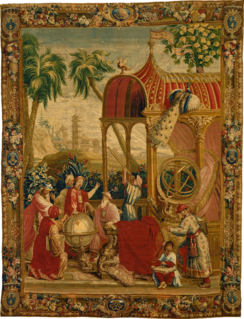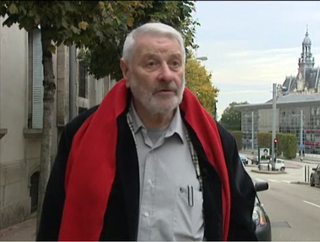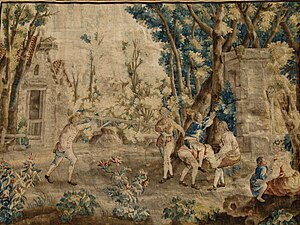
Aubusson is a commune in the Creuse department region in central France.

Tapestry is a form of textile art, traditionally woven by hand on a loom. Tapestry is weft-faced weaving, in which all the warp threads are hidden in the completed work, unlike cloth weaving where both the warp and the weft threads may be visible. In tapestry weaving, weft yarns are typically discontinuous; the artisan interlaces each coloured weft back and forth in its own small pattern area. It is a plain weft-faced weave having weft threads of different colours worked over portions of the warp to form the design.

The Gobelins Manufactory is a historic tapestry factory in Paris, France. It is located at 42 avenue des Gobelins, near Les Gobelins métro station in the 13th arrondissement of Paris.

Jean Lurçat was a French artist noted for his role in the revival of contemporary tapestry.

Jean Berain the Elder was a draughtsman and designer, painter and engraver of ornament, the artistic force in the Royal office of the Menus-Plaisirs du Roi where all the designs originated for court spectacle, from fêtes to funerals, and many designs for furnishings not covered by the Bâtiments du Roi. The "Berainesque" style of light arabesques and playful grotesques was an essential element in the style Régence that led to the French rocaille and European rococo.

Louis-Jean-François Lagrenée was a French rococo painter and student of Carle van Loo. He won the Grand Prix de Rome for painting in 1749 and was elected a member of the Académie royale de peinture et de sculpture in 1755. His younger brother Jean-Jacques Lagrenée was also a painter.

The Louis XV style or Louis Quinze is a style of architecture and decorative arts which appeared during the reign of Louis XV of France. From 1710 until about 1730, the period known as the Regency, it was largely an extension of the "Style Louis XIV" of his great-grandfather and predecessor, Louis XIV of France. From about 1730 until about 1750, it became more original, decorative and exuberant, in what was known as the rocaille style, under the influence of the King's mistress, Madame de Pompadour. It marked the beginning of the European Rococo movement. From 1750 until the King's death in 1774, it became more sober, ordered, and began to show the influences of neoclassicism.

The Musée Nissim de Camondo is an elegant house museum of French decorative arts located in the Hôtel Camondo, 63, rue de Monceau, at the edge of the Parc Monceau, in the 8th arrondissement of Paris, France. The nearest Paris Métro stops are Villiers or Monceau on Line 2.

The Beauvais Manufactory is a historic tapestry factory in Beauvais, France. It was the second in importance, after the Gobelins Manufactory, of French tapestry workshops that were established under the general direction of Jean-Baptiste Colbert, the finance minister of Louis XIV. Whereas the royal Gobelins Manufactory executed tapestries for the royal residences and as ambassadorial gifts, the manufacture at Beauvais remained a private enterprise. Beauvais specialised in low-warp tapestry weaving, although the letters patent of 1664, authorising the company and offering royal protection, left the field open for the production of high-warp tapestry as well.

Jean-Baptiste Monnoyer was a Franco-Flemish painter who specialised in flower pieces. He was attached to the Gobelins tapestry workshops and the Beauvais tapestry workshops, too, where he produced cartoons of fruit and flowers for the tapestry-weavers, and at Beauvais was one of three painters who collaborated to produce cartoons for the suite The Emperor of China.

Louis XVI style, also called Louis Seize, is a style of architecture, furniture, decoration and art which developed in France during the 19-year reign of Louis XVI (1774–1793), just before the French Revolution. It saw the final phase of the baroque style as well as the birth of French neoclassicism. The style was a reaction against the elaborate ornament of the preceding baroque period. It was inspired in part by the discoveries of ancient Roman paintings, sculpture and architecture in Herculaneum and Pompeii. Its features included the straight column, the simplicity of the post-and-lintel, the architrave of the Greek temple. It also expressed the Rousseau-inspired values of returning to nature and the view of nature as an idealized and wild but still orderly and inherently worthy model for the arts to follow.
Samuel-Jacques Bernard, comte de Coubert after the death of his father in 1739, was the son of the financier Samuel Bernard, a rich noble in France and his first wife, née (Anne)-Magdeleine Clergeau; he was superintendent of finance for Queen Maria Leszczyńska from 1725, a maître des requêtes, conseiller du roi and Grand Croix and Master of Ceremonies of the Order of Saint-Louis.

Jacques Dumont called "le Romain", was a French history and portrait painter, called "the Roman" from his youthful residence at Rome and to distinguish him from other artists named Dumont, notably his fellow-academician Jean-Joseph Dumont. His father, Pierre, was a court sculptor to the Duke of Lorraine and his elder brother, François (1687/88—1726), was also a sculptor. In addition to his paintings he practiced etching, in which medium he reproduced some of his paintings and, for example, Servandoni's view of the fireworks celebrating the marriage of the dauphin, 1730. Though comparatively unknown today, he enjoyed celebrity and a long, successful career.

The Aubusson tapestry manufacture of the 17th and 18th centuries managed to compete with the royal manufacture of Gobelins tapestry and the privileged position of Beauvais tapestry. Tapestry manufacture at Aubusson, in the upper valley of the Creuse in central France, may have developed from looms in isolated family workshops established by Flemings that are noted in documents from the 16th century.
The Jane Kahan Gallery is an art gallery located in New York City that deals almost exclusively with modern art in a variety of media including: works on paper, sculpture, and paintings. The gallery is best known for its extensive collection of tapestries by artists such as Romare Bearden, Alexander Calder, Marc Chagall, Sonia Delaunay, Max Ernst, Le Corbusier, and René Magritte, along with ceramics by Pablo Picasso. Established by art dealer Jane Kahan in 1973, the gallery was one of the first distributers of "Modern Master" works within the United States. The gallery maintains its original space on the Upper East Side and an exhibition space in Lower Manhattan.

Jean Fourton is a writer, humanist, painter and psychoanalyst.

Adrien Karbowsky was a French painter, decorator and architect, He is known for his Art Nouveau murals and tapestry designs.

The Style Louis XIV, also called French classicism, was the style of architecture and decorative arts intended to glorify King Louis XIV and his reign. It featured majesty, harmony and regularity. It became the official style during the reign of Louis XIV (1643–1715), imposed upon artists by the newly established Académie royale de peinture et de sculpture and the Académie royale d'architecture. It had an important influence upon the architecture of other European monarchs, from Frederick the Great of Prussia to Peter the Great of Russia. Major architects of the period included François Mansart, Jules Hardouin Mansart, Robert de Cotte, Pierre Le Muet, Charles Perrault, and Louis Le Vau. Major monuments included the Palace of Versailles, the Grand Trianon at Versailles, and the Church of Les Invalides (1675–91).




















